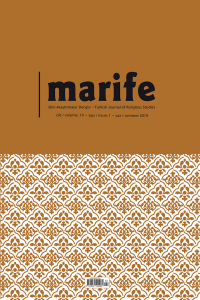
Marife Dini Araştırmalar Dergisi
Yazarlar: Mehmet CENGİZ
Konular:Din Bilimi
DOI:10.33420/marife.722485
Anahtar Kelimeler:Usul al- Fiqh,Dalalat (Signifying),Beyan(declaration),Has,Mutlaq-Muqayyad
Özet: This article is an examination on the application of the theory of declaration(beyan), which is a method to reach the goal of Shari’ Allah Almighty, on "pure word"(Has Lafz), one of the means of evidence. Has lafz in Hanafî method is divided into four section which are, Mutlaq, muqayyad, emr(decree), nahy(prohibiton). In the method of Mutaqallimîn, starting with Has lafz, every single lafz are evaluated separately. Since the purpose of this article is not to examine the differences between two methods that are based on classification and their reasons but to observe how beyan is applied on different lafz, for modal classification we used Hanafî method whereas for contextual basis both Hanafî and Mutaqallimîn methods are used. Mutlaq, the first type of Has lafz, is accepted as it is unless there is evidence that it is restricted. Hence it implies an obligation to act in accordance with it. As for muqayyad, the second type which is mentioned above, if a lafz stayed as muqayyad in one place at nas(Qur’an and Sunnah) and also did not appear as mutlaq in another place in nas, then it requires to act on it as muqayyad. If a word is found as mutlaq in one word and muqayyad in another, will each of the mutlaq and muqayyad lafz require one to act according to their place or will the purpose of the mutlaq be determined by muqayyad? " The question brings up the subjection of the mutlaq to muqayyad. According to some Hanafîs from Iraq it is not allowed to subject the Mutlaq to muqayyad and hence reduce two different nasses to one and act according to it. Because what should be done is to act seperatelt in accordance with those two different nasses without subjecting one to another. And for some other Hanafîs from Samarkand, to subject Mutlaq to muqayyad would mean Nash (to cancel the verdict of a verse by another verse). So, with the subjection method, Mutlaq’s verdict is cancelled by muqayyad and after that the verdict of Mutlaq is becomes unavailable. According to the fiqh schools other than Hanafî (Cumhur), the subjection of mutlaq to muqayyad means that muqayyad essentially interprets the Mutlaq. To them, just as âm lafz brings the possibility of has, and mujmal lafz brings the possibility of beyan, Mutlaq lafz brings the possibility of muqayyad. It generally takes two forms for a has lafz to appear as Mutlaq in one nas and muqayyad in another. Itlaq and Taqyid appear either in the reason of the verdict or verdict itself. In the subjection process of Mutlaq-Muqayyad, if Itlaq and taqyid appear in the reason of the verdict and the the verdict is the same in these two nasses, according to Hanafîs Mutlaq cannot be subjected to muqayyad. One should act in accordance with each nass separately. According to the rest of the fiqh schools, the subjection of mutlaq to muqayyad occurs and one must act upon muqayyad nass. For the subjection process between Mutlaq-Muqayyad, is Itlaq and taqyid appear in the verdict itself, four different situation emerges. In the first one, if the reason and the verdict are one, according to all of the fiqh schools, Mutlaq is to be subjected to muqayyad. For the second one, which is the reasons and verdicts are different, and the third one which includes different verdicts but same reasons, according to all of the fiqh schools Mutlaq is not to be subjected to muqayyad. The fourth one which means that the verdict is the same, but the reasons are different, according to Hanafîs Mutlaq is not to be subjected to muqayyad, whereas for Cumhur, mutlaq is to be subjected to muqayyad. Decree, the third typeof has lafz, signifies the necessity of what is decreed and unless there is a specific indication, decree is not to signify something other than a necessity. Nahy, the fourth type of has lafz, to both Hanafîs and Cumhur signifies a prohibition but according to Hanafîs, this sign must be constant via a certain path. Otherwise, if the new evidence appear as subût u zannî or dalâlati zannî, the thing that is prohibited can only indicates only a Makruh Tahrimi(abominable). Within ‘ılm al Usûl, there are two different views regarding the declaration of has lafz. According to the first view which ever meaning the has lafz is spoken/sent for, -if there are no indications otherwise- it absolutely signifies that meaning without a doubt. The majority / majority of the jurists, especially the Iraqi Hanafi scholars, are all agreed about this. But according to this view, what is meant by absolution is that the has lafz does not accept any other possibility other than the spoken evidence. The purpose does not indicate that has lafz does not accept any possibility other than its own meaning. According to the second view, while the has lafz signifies which ever meaning it is sent for, its verdict is not absolute. Because every fact carries the possibility of metaphor and every âm carries the possibility of particularity. Therefore, with the existing possibilities, the absoluteness is unimaginable.